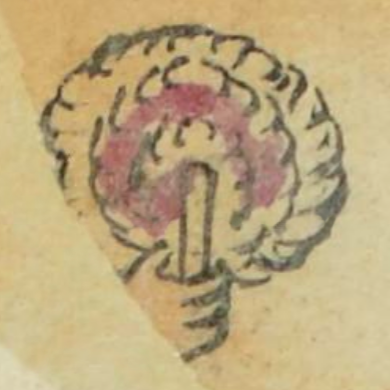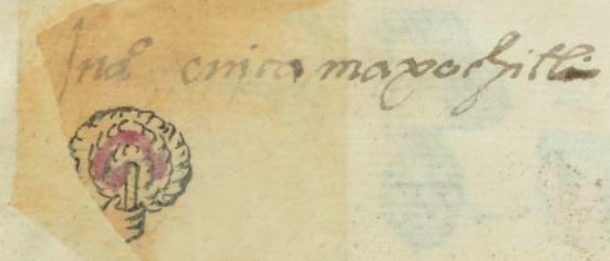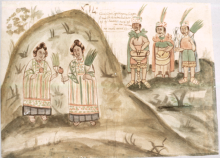Cuicamaxochitl (MH517v)
This simplex glyph for the personal name Cuicamaxochitl (perhaps "He Sings of Hand-held Flowers," attested here as a man's name) shows a hand (maitl) holding a flower (xochitl) fan that was apparently used while singing (cuica) and dancing. The hand is painted a flesh tone. The fan (shown in a frontal view but slightly cut off because the page is eroded) has some red coloring (really a pinkish or purple, but probably intending red). The flowers on the fan are arranged in concentric circles, emanating out for the center. It is the central circle that has the red coloring. A probably wooden stick runs partly up the middle of the fan, and the hand grabs onto this stick. The song (Cuica-) part of the name is not shown visually, but perhaps this fan offers the semantic value for singing.
Stephanie Wood
See the Digital Florentine Codex for a variety of fans (in these search results). The feather fan in Book 2, folio 106 verso, is much like the glyph in this record.
This fan may or may not be the ehecacehuaztli fan that the divine force of the wind carries in the Tonalamatl de los Pochtecas, a codex of Mixteca-Puebla origin (formerly called the Codex Fejervary-Mayer). See Mexicolore for a reproduction of the indicated page. If this fan is not the same, it has a similar construction and shape.
Fans with a circular shape mounted on a stick could also be made of feathers. The famous fan in the Museum für Völkerkunde, Vienna, is one such beauty. Red is the color of the central ring on this fan, too.
An understanding of the personal name Cuicamaxochitl may be enriched through the consideration of song lyrics. Bierhorst's Ballads of the Lords of New Spain (2010, 38) gives examples of a person or people equated with being a song: "I come created as a song, come fashioned as a song," "As a song you've been born, O Montezuma: as a flower you've come to bloom on earth," and "As songs you've come alive, as flowers you've blossomed, O princes."
Stephanie Wood
Juao cuicamaxochitl
Juan Cuicamaxochitl
Stephanie Wood
1560
Jeff Haskett-Wood and Stephanie Wood
nombres de hombres
This image comes from one of the copies of the Mapa de Cuauhtlantzinco (the one at Tulane), Scene 14. It is published in our Mapas Project, another digital collection, https://mapas.wired-humanities.org/cuauh/elements/cuauh14/000. This painting shows men drumming and women dancing while holding feather fans. On eof the men also holds a feather fan. Granted, the fans in this painting have a different shape than that of the glyph of record here.

cuica, to sing, https://nahuatl.wired-humanities.org/content/cuica
maxochi(tl), hand-held flowers, https://nahuatl.wired-humanities.org/content/maxochitl
Canción-Abanico de Flores
Stephanie Wood
Matrícula de Huexotzinco, folio 517v, World Digital Library, https://www.loc.gov/resource/gdcwdl.wdl_15282/?sp=114&st=image
This manuscript is hosted by the Library of Congress and the World Digital Library; used here with the Creative Commons, “Attribution-NonCommercial-ShareAlike 3.0 License” (CC-BY-NC-SAq 3.0).






